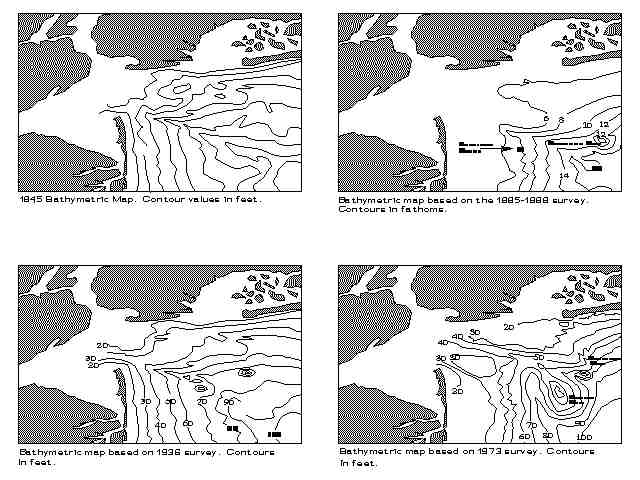
Any man-made object or material that winds up abandoned on beaches is an indication of recklessness, thoughtlessness, or catastrophe. Former economic policies regarding garbage disposal will continue to haunt inhabitants of the region indefinitely.
Past ocean dumping and ocean-side landfill development practices are contributing to the on-going accumulation of anthropogenic debris offshore and on area beaches. In certain places (particularly around Raritan Bay and portions of New York Harbor) discarded building material, household/industrial garbage, and other waste materials have become a major constituent of shore deposits. Along ocean-front beaches the grinding action of waves is helping to break down these materials. However, the same wave energy, along with tidal and storm currents, are working to redistribute these materials throughout the marine and coastal environments.
The Fresh Kills Landfill is ranked as one of the largest landfills on Earth, yet it is only one of many landfills situated in the low coastal zone in the New York Bight. These great piles of rubbish are the lasting legacy of our times. If sea level were to rise as little as two meters tidal and storm currents would begin to rework and redistribute materials in most area landfills throughout the coastal region. Marine flooding would contribute to slumping of the landfills. Exposed debris would then be vulnerable to combustion.
Few New York Bighters are aware of the incredible volume of debris contributed in the past to offshore dumpsites approved by U.S. Army Corp of Engineers. These official dumpsites have been in use since late in the 19th century and have been the repository of everything from household rubbish, cellar ash, and construction material to dredged sediments from shipping channels and building excavations rubble. Two undersea hills have risen on the sea bottom several miles offshore form both Sandy Hook and Breezy Point beaches (illustrated in the figure below). These hills have grown and eroded as materials have been intermittently dumped. The abundance of cinders on area beaches are evidence of this redistribution of sediments from offshore dumpsites. These materials will ultimately be reworked by coastal processes throughout the continental shelf and beyond in future regressions and transgressions of the sea.

Chemical and physical characteristics of anthropogenic materials (solubility, bioreactivity, density, hardness, size, and shape) help determine both how long materials are capable of persisting in the natural environment and where materials selectively accumulate. This is compounded by the quantity and rate that materials are generated, and by the method and location where materials are discarded.
Plastic is clearly the most problematic material in the environment because of its abundance, durability, and low density. It is a major hazard to marine life. Because of its low density it selectively accumulates on upper shore faces. Although an unsightly nuisance it generally degrades relatively rapidly (relative to other compounds) when exposed to sunlight or microbiotic activity. Plastic is problematic because it enters the ocean environment by many avenues, it is volummetrically abundant, and it currently escapes most practical recycling methods. Plastic on beaches comes from boaters, beach-goers, fishermen, street litter, and illegal dumping. Fortunately, the plastic debris problem is not as bad as it was in the 1960s to 1980s, thanks to a multitude of laws regulating ocean dumping, recycling, and landfill disposal.
Materials illustrated below represent common, problematic, and
unusual
anthropogenic materials collected on area beaches. Not all
anthropogenic materials
are "leaverites." During the collection of materials for this
report the writers found
money, gold jewelry, and both colonial and Indian artifacts.
However, a note of
caution before running off to the beach to collect... The amount
of money found in
relation to the hours spent collecting has only netted about
$.04/hour!

Indian arrowhead and pottery. Native American communities
probably existed in
lowland areas along the coast in areas now submerged during the
post-Ice Age
transgression. Stone and ceramic artifacts rarely survive
wave-grinding energy
and, therefore, are a scarce occurrence. Revisions to the
archeological record of the "New World" are constantly pushing
back the date of early human migrations into North America. An
article in the NY Times (Feb. 11, 1997, p. A1) describes
validation of archological sites at the southern tip of South
America as being over 12,000 year old. No doubt the NY Bight
shorelines (now submerged) were host to early, intermediate, and
late migrations of the ancestors of modern Native Americans.
Habitats along bays, beaches, and barrier islands they utilized
for food sources and settlements no longer exist.
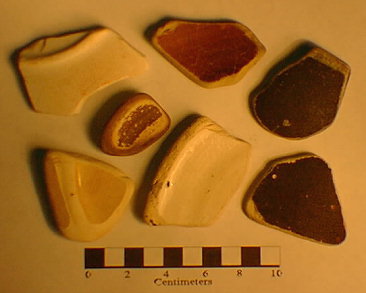
Broken ceramic pottery, crockery, cookware were commonly
discarded from
ships and dumped by local shore residents since colonial times.
Prior to
enforcement of the ban on ocean dumping these materials were part
of the general
New York City garbage discarded at sea. Their abundance,
hardness and durability
ensure their long-term archeological significance into the
distant future.
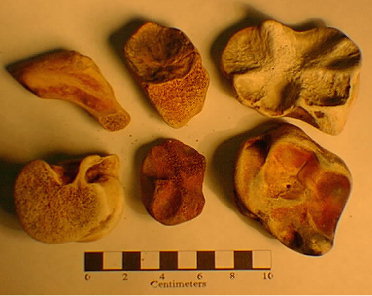
Only bone that displays "butcher marks" (i.e. saw marks) can
truly be considered
anthropogenic in origin. However, bone of cow, pig, and chicken
are quite
abundant on
area beaches; probably the accumulation of years of weekend beach
barbecues
and ocean dumping.
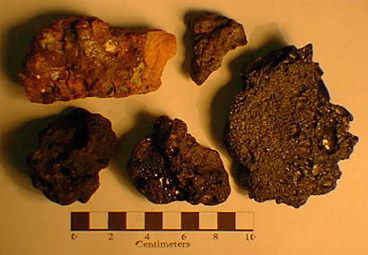
Smelting of iron, slag from burning coal on ships and by local
residents are sources
of glass-like cinders that are abundant on area beaches. Cellar
ash was a major
constituent of materials dumped offshore.
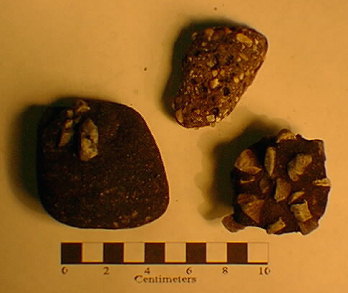
Incorrectly discarded pavement material and coastal erosion is a
source of asphalt
on area beaches. Fragments of asphalt and slate shingles also
wash up on the
coast.
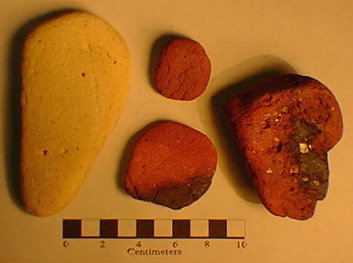
Wave-rounded brick material is fairly light and can be
transported long distances by
marine currents. Brick fragments make up substantial portions of
debris
on some area beaches where discarded building material has been
used as
fill.
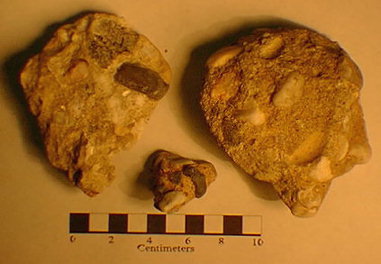
Concrete generally cannot withstand long-term exposure to salt
water, compared
to other anthropogenic materials. However, because concrete is
both
fairly light and abundant it is common on local coastlines.
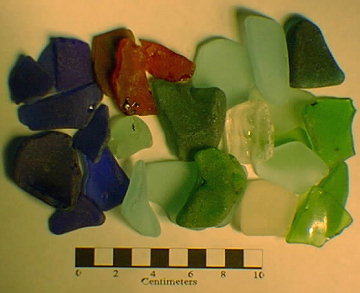
Freshly broken glass is a hazard on all area beaches.
Fortunately wave energy
quickly degrades sharp edges making smaller glass fragments which
are less
harmful, and are even pretty to look at. Glass is an extremely
stable compound
and will
likely survive in the environment for many millions of years.
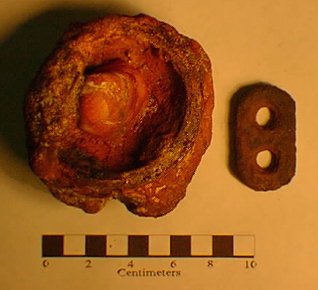
Iron and aluminum cannot withstand long-term exposure to sea
water. Iron rusts,
commonly forming clotted chunks with attached shell debris.
Aluminum oxidizes
to
become gibbsite (clay). Other metals are scarce by comparison.
Silver, copper,
tin, zinc, lead, and most other metals eventually dissolve in
seawater.
Only gold and platinum can withstand long-term exposure in the
surface
environment.
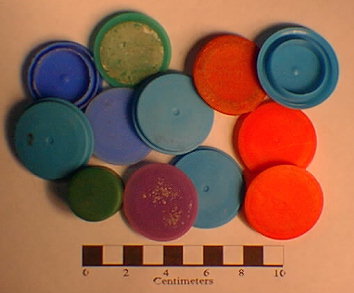
Plastics are the universal "stratigraphic marker" material of the
20th Century. Most
plastic eventually degrades, but by shear volume and its ability
to float to
remote regions of the world guarantee its presence in the
long-term geologic
record.
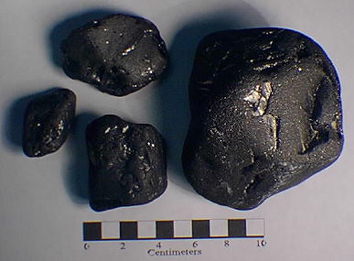
Coal is extremely abundant on area beaches. It is impossible to
tell whether coal on beaches are anthropogenic waste or a
"natural" occurrence. "Sea coal" was noted in abundance on
beaches of Long Island long before coal was mined in the
Appalachian region. It's low density and durable character
allowed vast quantities of coal to survive long-term transport
processes by rivers from the Appalachian coal fields to the
Atlantic coast. Most is bituminous ("soft" Appalachian coal).
Today the coal on area beaches is a mix of natural "sea coal" and
coal that was probably spilled from ships or were mixed with
discarded cellar ash during the 19th and 20th centuries.
Anthracite deposits of eastern Pennsylvania were generally
depleted before the turn of the century. Fragments of
anthracite are common in glacial sediments in New Jersey and is
common in Cretaceous to Recent alluvial sediment throughout the
region. Some coal-like materials on area beaches represent
coastal swamp accumulations of peat and
estuary tidal flat deposits. Examples are illustrated in the
fossil section of this report.
Tar balls, waxes, grease lubricants, and industrial resins are
also common on area
beaches. These materials are potentially toxic and pose a
significant danger to
both wildlife and humans, particularly to children playing on the
beach.
Unfortunately, tarballs, like plastic debris, are universally
found throughout the world's
oceans.
 Return to the
New York
Bight Home Page
Return to the
New York
Bight Home Page
Phil Stoffer and Paula
Messina
CUNY, Earth & Environmental Science, Ph.D. Program
Hunter College, Department of Geography
Brooklyn College, Department of Geology
In cooperation with
Gateway National Recreational Area
U.S. National Park Service
Copyright September, 1996
(All rights reserved; use as an educational resource
encouraged.)>